No edit summary Tag: rte-wysiwyg |
No edit summary Tags: Visual edit apiedit |
||
| Line 256: | Line 256: | ||
== Septaglyphs == |
== Septaglyphs == |
||
Written Sarus utilises a set of unique glyphs called 'septaglyphs' from the word septagon. Each glyph stands for a word rather than a syllable. Septaglyphs are constructed from a septagon figure with a centre point, and with the 7 syllables d, r, m, f, s, l and t going clockwise around the outside points. This is the basis for Sarus septaglyphs. The 7-sided figure is merely a guide shape and is not used when actually writing Sarus. It's merely a guide shape for beginners. We'll be using it as a background for glyphs here but before the end of this lesson we'll lose it. |
Written Sarus utilises a set of unique glyphs called 'septaglyphs' from the word septagon. Each glyph stands for a word rather than a syllable. Septaglyphs are constructed from a septagon figure with a centre point, and with the 7 syllables d, r, m, f, s, l and t going clockwise around the outside points. This is the basis for Sarus septaglyphs. The 7-sided figure is merely a guide shape and is not used when actually writing Sarus. It's merely a guide shape for beginners. We'll be using it as a background for glyphs here but before the end of this lesson we'll lose it. |
||
| + | |||
| ⚫ | |||
[[File:Septagon.jpg|thumb|left|100px]] |
[[File:Septagon.jpg|thumb|left|100px]] |
||
| ⚫ | |||
| ⚫ | |||
| ⚫ | |||
There is only ever one straight line in any septaglyph. That's the first syllable. This straight line shows at a glance what the first syllable is. |
There is only ever one straight line in any septaglyph. That's the first syllable. This straight line shows at a glance what the first syllable is. |
||
| + | [[File:Sept_d.jpg|thumb|100px|The septaglyph for the word d/do meaning "no, not"]]'''Rule 2: Single syllable words are capped.''' |
||
| ⚫ | |||
| ⚫ | |||
| − | |||
| − | '''Rule 2: Single syllable words are capped.''' |
||
| ⚫ | |||
| − | |||
| ⚫ | You already know that the first syllable is drawn from the centre to the first syllable. Instead of a cap though, continue the stroke to the next syllable. There are strict rules for how these lines are drawn. Without the background, accurate curves are the only |
||
[[File:Sept_dr.jpg|thumb|left|100px]]'''Rule 3: Neighbouring syllable, curve outwards.''' |
[[File:Sept_dr.jpg|thumb|left|100px]]'''Rule 3: Neighbouring syllable, curve outwards.''' |
||
| − | Going from one syllable to a neighbouring syllable (such as 'dr', 'tl', 'sf', etc) the line always curves outwards, as above. |
+ | Going from one syllable to a neighbouring syllable (such as 'dr', 'tl', 'sf', etc) the line always curves outwards, as above.[[File:Sept_dm.jpg|thumb|100px]]'''Rule 4: When skipping one syllable, always curve the line inwards''' |
| − | |||
| − | |||
| − | |||
| − | '''Rule 4: When skipping one syllable, always curve the line inwards''' |
||
| ⚫ | |||
| − | |||
| ⚫ | |||
'''[[File:Sept_df.jpg|thumb|left|100px]]Rule 5: When skipping two letters, the line should have a slender s-shape''' |
'''[[File:Sept_df.jpg|thumb|left|100px]]Rule 5: When skipping two letters, the line should have a slender s-shape''' |
||
Revision as of 00:46, 13 December 2016
Sarus, or the shadow tounge, is a language originally spoken by the YuYu that was adopted for use as a means of universal communication by the ancient, and now mysteriously vanished inhabitants of Brackenwood.
History
Sarus are spoken by the YuYu, the cross-dimensional shadow people known stealing people from various worlds as they sleep, and bringing them to their shadowy realm to work as slaves. At some point the language was adopted for use as a means of universal communication across the planet of Brackenwood by the ancient, and now vanished, people of Brackenwood, the Viccans and the Dashkin.
Grammar
The roots of Sarus lie in the 7 notes of the musical octave: do, re, mi, fa, so, la, ti which can be abbreviated to just one letter each:
- d, r, m, f, s, l, t
Those are the letters of Sarus, called syllables. Every Sarus word is a combination of one or more of those syllables. There are seven 1-syllable words, which are:
- d, r, m, f, s, l, t
After those, we move on to the 2-syllable words, of which there are 49. They are:
- dd, dr, dm, df, ds, dl, dt
- rd, rr, rm, rf, rs, rl, rt
- md, mr, mm, mf, ms, ml, mt
- fd, fr, fm, ff, fs, fl, ft
- sd, sr, sm, sf, ss, sl, st
- ld, lr, lm, lf, ls, ll, lt
- td, tr, tm, tf, ts, tl, tt
Next come the 3-syllable words, of which there are 336.
Words
Sarus words are written as a combination of any of the 7 syllables.
Example:
- s - this is a 1-syllable Sarus word that means 'if'.
- drt - this is a 3-syllable Sarus word that means 'create' or 'make'.
- tl - this is a 2-syllable Sarus word that means 'cannot'
Sentences
Sentences are written just like in most other languages, with a space separating the words, like so:
- dms m ft frf - today is very windy
Synonyms
The language of Sarus is a very limited one, but it is not limiting. One important rule is that there should not be two or more words that mean the same thing. The vocabulary of Sarus is based some of the 1000 most common English words, a huge percentage of which is synonyms or words very similar to others. In Sarus synonyms do not exist. For example, the words: strange, weird, bizarre, odd, queer all mean pretty much the same thing, so in Sarus there is just one word that expresses them all: mrf.
Certain words are also mixed where it's logical and works in context:
- d = no, not, don't, isn't, won't
- dms = day, today
- smd = night, tonight
- mrf = weird, bizarre, strange
- rfm = small, little
Overlap
There are some overlapped definitions in Sarus. Examples:
- heavy - light - dark. In English, the opposite of heavy is light. The opposite of dark is also light. Therefore, heavy and dark share the same Sarus word: srf.
- gentle - rough - smooth. In English, the opposite of gentle is rough. The opposite of smooth is also rough. Therefore, gentle and smooth share the same Sarus word: fml.
Incidentally, the latter example also has a double-up definition, meaning that the Sarus words fml and lmf each have multiple definitions:
- fml = gentle, smooth, clean
- lmf = rough, dirty
Therefore to say in Sarus that the texture feels rough, is the same as saying it feels dirty. Usually the context helps. If someone is on a boat and the sea is choppy, and they were to say: "l ltm m lmf dms", it's highly likely that it would be understood in context as saying "the sea is rough today", and not "the sea is dirty today".
Phonology
Sarus, being heavily based on Solresol, have 7 "syllables" in the entire vocabulary. Those are the 7 major notes of the musical octave: Do, Re, Mi, Fa, So, La, Ti.
Words in Sarus comprise of one, or a combination of several, of the syllables. For example, three syllables Do, Re and Mi when strung together become the Sarus word “doremi”, which translates as ‘the same’. The major obstruction with Solresol was that words needed to be separated by gaps. Therefore, when spoken or played on a musical instrument, any phrase was a stop-start affair, sounding very disjointed. This also made the language very slow, making it cumbersome and inefficient as a language for everyday communication.
The pronunciation system of Sarus is similar to certain other languages by using something similar to syllable stress. The first syllable of every word (called the Prime Syllable) is stressed slightly. Furthermore, the prime syllable is pronounced a little differently to other syllables in the same word. The combination of those two rules make the start of each word easily recognisable, so that by using this method, words may be spoken without gaps separating them. The pronunciation for the seven syllables when used as a word's prime syllable are:
- Do – pronounced ‘doe’
- Re – pronounced ‘ray’
- Mi – pronounced ‘mee’
- Fa – pronounced ‘faa’
- So – pronounced ‘so’
- La – pronounced ‘laa’
- Ti – pronounced ‘tee’
All other syllables in the word, called Latter Syllables are pronounced differently. All latter syllables are pronounced with their vowels replaced by an ‘uh’ sound. Therefore, all latter syllables in a word are pronounced as follows:
- do – pronounced ‘də’
- re – pronounced ‘rə’
- mi – pronounced ‘mə’
- fa – pronounced ‘fə’
- so – pronounced ‘sə’
- la – pronounced ‘lə’
- ti – pronounced ‘tə’
A Sarus word in its entirety is made up of anywhere from one to 5 or even 6 syllables. For example, the word faedmir means ‘almost’ and consists of the syllables: Fa, Do, Mi, Re. Fa is the prime, and do mi re are the latters. This word is thus pronounced as follows: Fadəmərə (faa-duh-muh-ruh). When spoken, the ‘ə’ of the final syllable may be dropped. Not only does this streamline the word, but it also makes the ending recognisable: Fadəmər (fa-duh-mur)
The syllable ‘Re’ can become difficult to pronounce when it appears twice in a row. For example the question “Am I coming?” translates as follows: Rerə Dorə Rerədə. To make this easier, a double ‘re’ makes use of the consonant ‘k’. The second of the two is changed to ‘kə’, so that 'Rerə' becomes ‘Rekə’. Therefore, the above question "Am I coming?" is much easier pronounced: Rekə Dorə Rekəde. But there is still a double 're' between Dorə and Rekəde. When the sentence is said aloud, the latter ‘rə’ in Dorə is followed closely by the prime Re in Rekədə. To combat this, whenever necessary, 'k' is is used for the problem, however the 'k' consonant cannot be used on a prime syllable, so with this change and the final syllables dropped, the sentence is pronounced as: Rek Dok Rekəd.
The use of 'k' is for pronunciation purposes. When writing the abbreviated form of Sarus words, for example "ssf dr rmtr" (give me permission) the double 'r' remains. When writing, there is no k in abbreviated Sarus. Sarus words contain various combinations of vowels amongst the consonant syllables. Those vowels are inconsequential to the meaning as the language is based on the solfege syllables D R M F S L T, and so they alone are the important parts of the word, and essential for correct translation. Therefore, “remitur” means the same as raemytir, romutar or even rhymethehour. Each of those words contain the exact same Sarus syllables in the same order: RMTR. The vowels in a word are merely padding.
Getting the syllables correct is important, because this is the skeleton of the word, which translates to colour, melody and hand signals.
Nouns
Pluralization
Plurals for Sarus nouns are expressed by adding another syllable to the end of the word. But it can't be any old syllable. The "pluralize" syllable used depends on what the final syllable of the singular word is. The pluralizing syllable will be whatever comes after the final syllabe of the singular word.
For example:
- tooth = mds <- - singular
- teeth = mdsl <- - plural
The pluralizing syllable is l because it comes after s (d, r, m, f, s, l, t).
Triple syllables are never used in Sarus. So ddd, rrr, mrrr, tttf, etc. don't exist. There are many words in Sarus that contain double syllables though. Using a standard syllable to pluralize (for example, just adding d at the end), would give a tripple syllable in every word ending with dd. For example, rdd (edge), rddd (edges). This goes against the 'no tripple syllable' rule. So by making the pluralizing syllable dependent on the final syllable of the word, there cannot be clashes, or rule-breaking exceptions. If t is the final syllable of the singular, then d will be the pluralizing syllable. Overall, in all 4 syllable nouns, if the last two syllables are consecutives, then the word is a plural of something.
Pronouns
Verbs
'ing' verbs
Verbs such as 'go' can be turned into 'going' by putting 't' before it. This literally means 'be go' but translates as 'going'.
- drr - go
- t drr - going
- -- - --
- fdt - eat
- t fdt - eating
- - --- -
- mdt - walk
- t mdt - walking
Conjugation
Questions
Reversing a word in Sarus generally reverses the meaning. However with most of the question words, there is no opposite so reversing the word changes the meaning to another question word.
- fr - when?
- rf - where?
- -- - -
- rm - what?
- mr - who?
The exception here is 'why?' whose opposite is 'because'.
- rs - why?
- sr - because
This is the only question word whose opposite is not another question word.
Answers
Questions that begin with the question prefix 'rr' generally call for a yes/no response. In Sarus, 'be' and 'not' are used to mean 'yes' and 'no'. Examples:
- Question: rr dm t drr - you be go? (are you going?)
- Answer: t - be (yes I am)
- -- - -
- Question: rr df t ml - he be here? (is he here?)
- Answer: d - not (no he's not)
Another way to answer is to confirm/deny the question:
- Question: rr dm rmm dr - you see me? (do you see me?)
- Answer: rmm - see (yes I see you)
- --- -- -
- Question: rr dm mrr df - you have it? (do you have it?)
- Answer: d mrr - not have (no I don't have it)
Answering negative/affirmative in this way is not possible when the other question words are used, such as 'where have you been?' or "what are you doing?". Instead the question words require a more explanatory response, rather than a simple yes or no. Examples:
- Question: rf dm t drr - where you be go? (where are you going?)
- Answer: dr t drr lm - I be go there (I'm going there)
- or, more simply
- Answer: lm - there (I'm going there)
Prefixes
Question prefix
Questions in Sarus must use a question word. A question word can either be what, why, who, etc, or it can be the question prefix, 'rr' (pronounced 'rek'). If there is no question word or question prefix, it is just a sentence. Unlike in English where we end our questions with a question mark, in Sarus we put 'rr' at the beginning. This prefix is the difference between a sentence and a question:
- dm t drr - you are going.
- rr dm t drr - are you going?
- - -- -
- dr t fmd - I am late.
- rr dr t fmd - am I late?
- -- --
- ml - here.
- rr ml - here?
The question prefix is not necessary when another question word is used, such as 'who is there?', or 'when are we going?'
Command/suggestion prefix
The command or suggestion prefix, 'dd', is used to turn a verb into a command or suggestion by placing it at the beginning of the word. A command is simply "DO IT NOW!" Placing 'dd' in front of the verb 'frt' (like) and adding 'dr' (me) afterwards gives:
- Dd frt dr - LIKE ME!
It works the same with the future prefix 'll' (will):
- Dr ll frt dm - I will like you
Future/past prefix
In order to encode a verb with the past tense, the past prefix 'tt' is placed before the verb, like so:
- sml - break
- tt sml - broken
- rrm - do
- tt rdm - done
The past prefix is also used to turn a noun into an adjective or superlative form, like so:
- ms - good
- tt ms - best
- sdr - loud
- tt sdr - loudest
- fl - more
- tt fl - most
The word 'tt' can be used by itself to mean "most".
Future tense is encoded by placing the future prefix, or ll in front of the verb. As with 'tt' the word 'll' also have its own meaning by itself, which is "will".
Numbers
The number system in Sarus is very straight-foward:
- d = 0
- r = 1
- m = 3
- f = 5
- s = 7
- l = 9
- t = +1
In order to indicate that the word is a number and not an ordinary word 'sts' (number) is placed in front of the number and 'dd' at the end to indicate the end of the number, so "I saw 347 people" becomes: ss dr rrm sts mmts dd drlt.
By adding 't' to a digit, you can keep counting higher:
- d = 0
- r = 1
- rt = 2
- m = 3
- mt = 4
- f = 5
- ft = 6
- s = 7
- st = 8
- l = 9
However t = +1 to a digit and not an entire number, so t cannot be used with d, l, or itself, as it breaks this rule, and therefore the following numbers do not exist:
- dt
- lt
- tt
- mtlt
- dtft
- ttf
- lldt
- etc.
Examples of legit numbers are:
- rtm = 23
- rtmt = 24
- mmtfffl = 345559
- lld = 990
- rlsr = 1971
- rlstmt = 1984
Septaglyphs
Written Sarus utilises a set of unique glyphs called 'septaglyphs' from the word septagon. Each glyph stands for a word rather than a syllable. Septaglyphs are constructed from a septagon figure with a centre point, and with the 7 syllables d, r, m, f, s, l and t going clockwise around the outside points. This is the basis for Sarus septaglyphs. The 7-sided figure is merely a guide shape and is not used when actually writing Sarus. It's merely a guide shape for beginners. We'll be using it as a background for glyphs here but before the end of this lesson we'll lose it.
Rules for septaglyphs
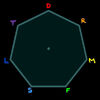
Rule 1: Every septaglyph is started from the centre.
There is only ever one straight line in any septaglyph. That's the first syllable. This straight line shows at a glance what the first syllable is.
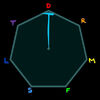
The septaglyph for the word d/do meaning "no, not"
Rule 2: Single syllable words are capped.
Like the 'd' above and the 'l' below, a capped line indicates a 1-syllable word. A cap on a single syllable is like a dot on the letter i.. it's not entirely necessary but makes it easier to see for beginners to see where the line started and ended.
You already know that the first syllable is drawn from the centre to the first syllable. Instead of a cap though, continue the stroke to the next syllable. There are strict rules for how these lines are drawn. Without the background, accurate curves are the only means of interpreting a glyph.
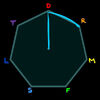
Rule 3: Neighbouring syllable, curve outwards. Going from one syllable to a neighbouring syllable (such as 'dr', 'tl', 'sf', etc) the line always curves outwards, as above.
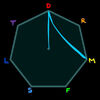
Rule 4: When skipping one syllable, always curve the line inwards
As shown above, the glyph goes from 'd' to 'm'.. we've skipped one ('r') so the line curves in.
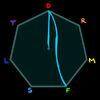
Rule 5: When skipping two letters, the line should have a slender s-shape
Going from 'd' to 'f' (skips past 'r' and 'm') he s-shape must first curves away from the centre point of the glyph. Therefore, 'df' will be a mirror image of 'ds'.
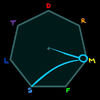
Rule 6: Double syllables are indicated with a little circle
The circle is on 'm', therefore it's double 'm' followed by 's'. The line from 'm' to 's' is curved inwards.
Rule 7: Going back to a syllable is indicated by a little line along that of the second syllable.
For example, in 'lrl', the first line goes from the centre to 'l', then the s-shape line to 'r'. To indicate going back to 'l', draw a smaller line along the 'r' line, as below:
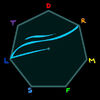
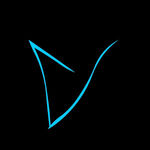
The septaglyph for the word "dlr" (fool, trick, confuse) without the guide figure.
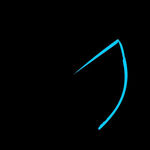
The septaglyph for the word "rmf" (until).

The septaglyph for the word mrf (strange, odd, weird, queer, bizarre).
Behind the scenes
- The language was developed by Adam Phillips specifically for use in the Brackenwood universe. It utilises the solfège musical notes as syllables and was inspired by "Solresol", a conlang created by Jean Francois Sudré in the 19th Century. When developing the language Phillips downloaded lists from the internet of the 1,000 most common English words and based it on them. The language can be learned and spoken and has its own glyphs, known as septaglyph. Lessons are available on Adam Phillips' website, on the Sarus section (see external links below.) A lot of new vocabulary was developed through the help of online users on Phillips' forums.
External links
- Sarus page on Adam Phillip's website with lessons
- Sarus boards on Adam Phillips' online forums
- Sarus dictionary 2
- Septaglyph guide on Adam Philips' online forums
- The Ultimate Sarus Toolkit, a list of Sarus resources on Adam Phillip's online forums
